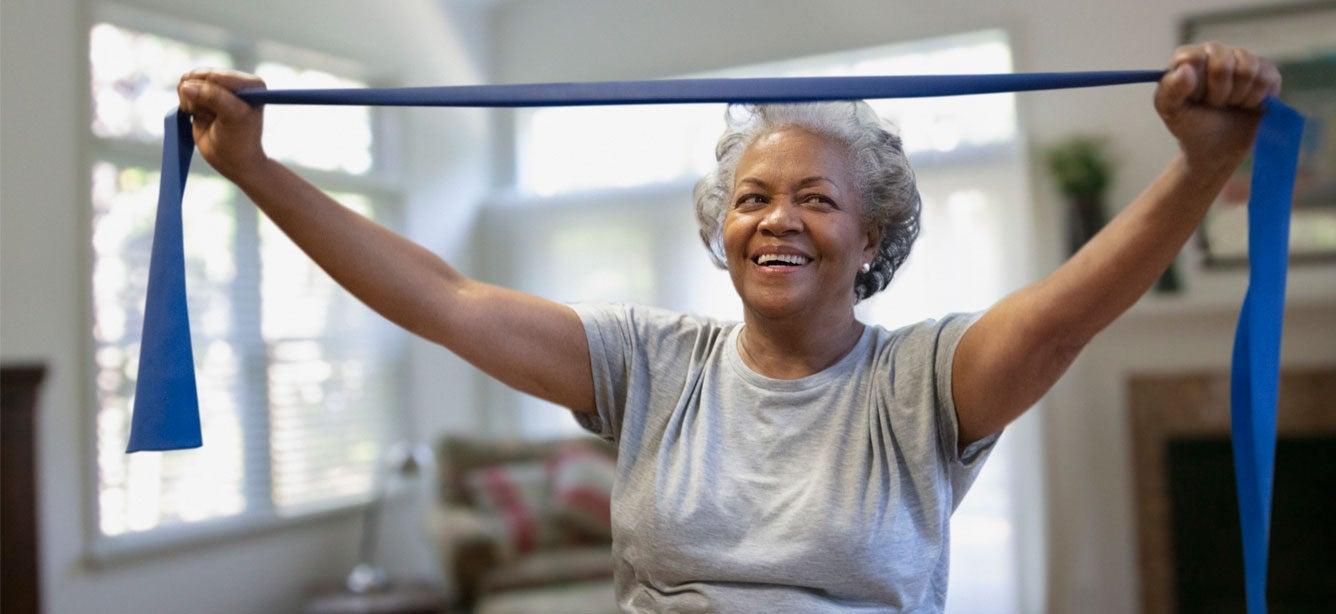Optional Data Fields in the Healthy Aging Programs Integrated Database
10 min read

What data elements are included in Healthy Aging Programs Integrated Database (HAPID)?
The data fields tracked in HAPID® are updated in accordance with ACL requirements. Community-based organizations funded by the Administration for Community Living to implement evidence-based chronic disease self-management education (CDSME) and falls prevention programs are required to collect specific data elements using forms approved by the Office of Management and Budget (OMB). All forms approved by the OMB include an expiration date for review and revision. Typically, new forms are available on or around the expiration date. Be sure that your network partners are using the most current forms.
In addition, NCOA’s Center for Healthy Aging (CHA) offers several optional fields in the database, which you can incorporate into your data collection tools. Optional items are often requested by database users or program leads through technical assistance calls, surveys, or recommended by NCOA staff to better monitor important programmatic changes and improve monitoring. We consider incorporating data fields that have the potential to benefit multiple grantees and networks.
If you have a question that you would like to add to the optional data fields, please email the database manager, Angelica Herrera-Venson (angelica.herrera-venson@ncoa.org). Items that may conflict with or are similar to existing OMB required questions are typically rejected. Occasionally, questions are required for one program type (e.g. CDSME programs) but optional for another program type (e.g. falls prevention programs) or vice versa.
At this time, sensitive data, or data that can be used in combination with other fields to identify a person are not collected. This includes names, Medicare numbers, Social Security numbers, medical record numbers, participant-level ZIP codes, or dates of birth.
Optional_Items_Healthy_Aging_Programs_Integrated_Database_2023%20%282%29
Participant-Level Items
Rurality
| Topic | Rurality |
| Why | Due to popular demand, NCOA and ACL have agreed to provide an optional field to help organizations capture rurality data from participants. This will help grantees get a better picture of the extent to which they are reaching rural communities. This question derives from the National Survey of Older Americans Act Participants (NSOAAP). The instruments are linked mid-page. |
| Question | Is your home located in… (check only one) |
| Answer Choices | □ The city □ The suburbs □ A rural area □ Refused □ Don’t know |
Health Insurance
| Topic | Health Insurance |
| Why | Collect information on the types of health insurance used by participants. Identifying the health insurance coverage of participants in your program can inform your value proposition to health payors. Include this measure in your survey if you are interested in propositioning health payors to extend coverage to your evidence-based program(s). Use this information to calculate return on investment and make your best pitch. |
| Question | Which of the following best describes your health insurance coverage? (Please put “X” in all boxes that apply, e.g. ☒)[Health Insurance] |
| Answer Choices | Medicare (Original) Medicare Advantage Plan –(HMO, PPO, Fee-for-Service, Medical Savings Account) (Please specify: _______________) Medicare Advantage Plan –(Special Needs Plans (including Dual-Eligible SNP) (Please specify: _______________) Medicaid Employer or Union-based Health Insurance Veteran’s Health Care Benefits/Coverage Veteran’s Health System TRICARE/ TRICARE for Life Indian Health Services No Insurance Other Private Insurance (Please specify): ________________________ |
Monthly Household Income
| Topic | Monthly Household Income |
| Why | This question provides information to assess whether programs and services are reaching vulnerable, low-income older adults. The narrow brackets (~$500) when coupled with the required question on ‘Living Alone (Y/N)’, can be used to estimate the individual's Federal Poverty Level. Use this question if you are interested in who you are serving and who you are missing in terms of vulnerable, low-income older adults. This question can also add to identifying which programs are most appropriate for which population. Identifying the Federal Poverty Level is a powerful indicator of your impact on struggling segments of the older adult population. |
| Question | Including yourself (and your spouse, if married), what is your combined monthly gross income now? (Consider all sources of income, including Social Security, pension, etc.)? [Monthly Income] |
| Answer Choices | Less than $1,000 $1,001 -$1,499 $1,500 -$1,999 $2,000 -$2,499 $2,500 -$2,999 $3,000 -$3,499 $3,500 -$3,999 $4,000 or more |
Program Satisfaction
| Topic | Program Satisfaction |
| Why |
Many organizations may be offering multiple programs, or just getting their programs off the ground. If you’re interested in measuring participants’ satisfaction and overall experience with the program, consider adding a satisfaction question(s). Response options are on a 5-point Likert scale. Understanding the satisfaction with the program can provide insight into many aspects of its delivery. You should use program level data to understand the logistical side of program planning, including satisfaction with the leaders, the time offered, the location, and other factors you may not have considered. This is part of the continuous quality improvement process. |
| Option 1: Question |
Satisfaction with the program: How would you rate your overall satisfaction with the quality of the program? Note: Beginning in May 2023, CDSME OMB-approved forms require the question “How would your rate your overall satisfaction with the quality of the program?”. In addition to this question, you may be interested in using the following related questions. This question remains options for Falls Prevention grantees. |
| Option 1: Answer Choices | Very Dissatisfied Dissatisfied Okay Satisfied Very Satisfied |
| Option 2: Question | Satisfaction with location: How would you rate your overall satisfaction with the location of the program? |
| Option 2: Answer Choices | Very Dissatisfied Dissatisfied Okay Satisfied Very Satisfied |
| Option 3: Question | Satisfied with time: How would you rate your overall satisfaction with the time of the program? |
| Option 3: Answer Choices | Very Dissatisfied Dissatisfied Okay Satisfied Very Satisfied |
| Option 4: Question | Satisfaction with leader: How would you rate your overall satisfaction with the leader(s)of the program? |
| Option 4: Answer Choices | Very Dissatisfied Dissatisfied Okay Satisfied Very Satisfied |
Referrals
| Topic | Referrals |
| Why | Wondering whether your marketing and recruitment efforts are paying off? Curious if that new partnership with the local clinic is yielding a steady flow of referrals? Did anyone act on your Facebook ads and social media campaigns? You can use several options in the database to create your own questions and track the effectiveness of your efforts. Use this question if you are interested in knowing how participants found out about the program to better inform how you spend your resources on advertising. This could also be an important question to ask to identify which providers are referring their patients to your program. This would be an opportunity to collaborate and partner to enhance and expand referral sources. |
| Question | Where did you hear about [program name]? (Please put “X” in all boxes that apply, e.g. ☒.) [Referral Source] |
| Answer Choices | I was referred by my doctor or other medical provider I heard about it from friends or family This is a benefit offered through my health insurance (If yes, please name health insurance plan) I responded to an advertisement or invitation from a local organization (If yes, please name the organization) I saw a Facebook ad or other Facebook notice I heard about it through other social media (e.g. Twitter, Instagram) k) (If yes, please specify) Other, please specify: |
Workshop-level items
The following optional fields are not marked as such in the workshop data entry user interface:
Program Format
| Topic | Program Format |
| Why | Since the COVID-19 pandemic, there has been increasing interest in understanding the formats in which grantees have been delivering workshops, such as whether they were delivered remotely through web-conference tool like Zoom, or whether participants were issued a toolkit and received phone support. ACL approved a set of required questions about the workshop format. These will replace any existing optional questions that NCOA has offered to date. We hope the new set of questions will simplify this documentation. |
| Selections: Delivery Mode |
How was the program delivered? (Check all that apply) |
The following Optional Fields are unique to Falls Prevention programs.
Tracking Participant Completion in Long-Form Programs
| Topic | Tracking Participant Completion in Long-Form Programs |
| Why | Add this question if you would like to better track participant completion rates across long-form programs (e.g., SAIL, Tai Ji Quan: Moving for Better Balance) that you implement across multiple workshops; For example, if you implement the Tai Ji Quan: Moving for Better Balance program as two 12-week workshops (meeting twice a week for 1 hour each), in which the participant completes a participant survey at the beginning and end of each workshop block. This question helps to more reliably match participant IDs on the back end of the database, thus resulting in a more accurate participant completion rate in data reports. This question is available in English, Spanish, Cambodian, Chinese, Hmong, and Vietnamese. |
| Question | Have you taken this falls prevention program before? |
| Answer choices | Yes No |
Tracking Participation in Other Fall Prevention Programs
| Topic | Tracking Participation in Other Fall Prevention Programs |
| Why | This question helps to track if a participant has attended another fall prevention program before. It is especially helpful in tracking if participants engage in a continuum of programs, such as attending a moderate- to high-falls risk program like A Matter of Balance and then enrolling in a lower-falls risk program like Tai Chi. This question is available in English, Spanish, Cambodian, Chinese, Hmong, and Vietnamese. |
| Question | Have you taken a falls prevention program before? |
| Answer Choices |
Yes If yes, please indicate the program name: _________ |
Functional Measurement Assessments
| Topic | Functional Measurement Assessments |
| Why | Add the Timed Up and Go (TUG) and/or the Chair Stand functional measurement assessments to your data collection process to assess mobility, leg strength, and endurance pre- and post- program. Collecting these measures would allow you to assess if the participant has improved, maintained, or declined in their ability after participating in the program. These tests are to be conducted and recorded by program leaders and/or professionals. |
| Assessment: Timed Up and Gp | Conduct this test pre- and post-program to assess the participant’s mobility. |
| Record: Timed Up and Go |
Program leaders record the number of seconds on the Participant Information Form (Pre-Survey) and Participant Post-Survey. Test administration instructions for program leaders are available here. Text to Add to Pre-and Post-Program Surveys (For Program Leader Use Only): Timed Up and Go Test Number of Seconds:_____ |
| Assessment: Chair Stand Test | Conduct this test pre- and post-program to test the participant’s leg strength and endurance. |
| Record: Chair Stand Test |
Program leaders record the participant’s score on the Participant Information Form (Pre-Survey) and Participant Post-Survey. Test instructions for program leaders are available here. Text to Add to Pre-and Post-Program Surveys (For Program Leader Use Only): Chair Stand Test Score:_____ |
Caregiver for Person with Dementia
| Topic | Caregiver for Person with Dementia |
| Why | Add this question to identify if the program participant is a caregiver for a person with dementia. In some programs, caregivers for participants with dementia attend the program to assist the care recipient and/or learn how to help the care recipient prevent falls. This is currently available only in surveys/forms associated with falls prevention programs. |
| Question | Are you here as a caregiver to a person with dementia? |
| Answer choices | Yes No |
STEADI Screening Tool
| Topic | STEADI Screening Tool |
| Why | Add the STEADI survey questions (including Falls Risk Survey, Balance Tests, and Functional Fitness Tests) to evaluate a participant’s pre- and post-program fall risk. |



